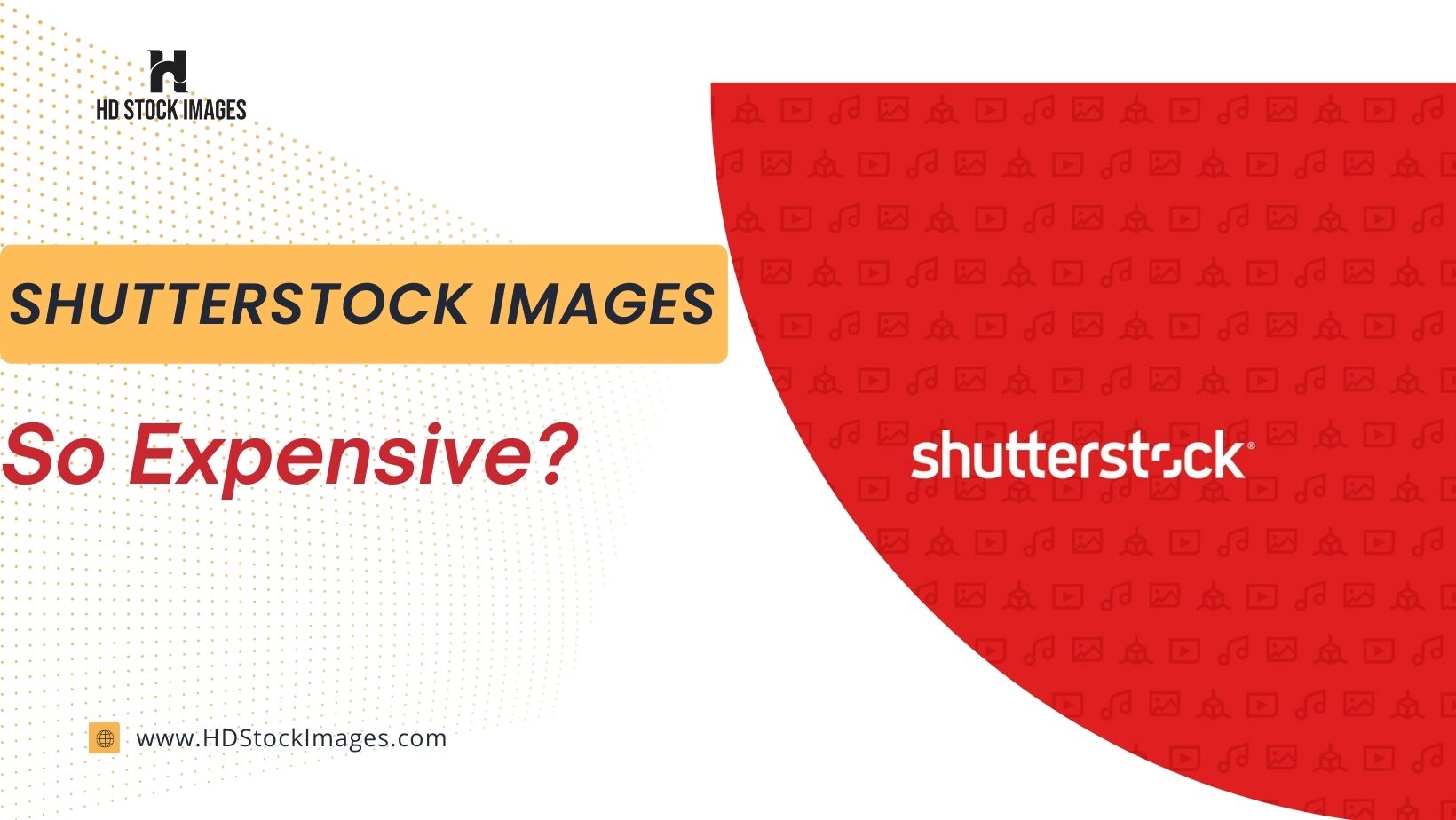1. Introduction:
Stock photography has become an essential resource for professionals across industries, providing access to high-quality images for various creative projects. Among the prominent stock photography platforms, Shutterstock stands out, but one question often arises: why are Shutterstock images so expensive? This blog post explores the factors influencing the pricing and value of Shutterstock images.By understanding the pricing structure, quality, and variety of images, infrastructure, and resources, and comparing them with other platforms, we can gain insights into the perceived high pricing. By delving into these factors, we can better understand the investment required for Shutterstock images and assess the value they provide for professionals' creative endeavors.Also Read This: Is Shutterstock Good for Selling Photos? Evaluating the Platform’s Effectiveness
2. Understanding the Pricing Structure of Shutterstock:
 Shutterstock employs a pricing structure that offers flexibility and caters to different user needs. Here's an overview of the pricing models used by Shutterstock:
Shutterstock employs a pricing structure that offers flexibility and caters to different user needs. Here's an overview of the pricing models used by Shutterstock:1. Subscription Plans:
Shutterstock offers subscription plans that provide access to a fixed number of image downloads per month or year. These plans are suitable for users who require a high volume of images on an ongoing basis. Subscribers pay a fixed fee and can download a certain number of images within their subscription period. Subscription plans offer cost savings compared to on-demand purchases.2. On-Demand Purchases:
For users with sporadic or infrequent image needs, Shutterstock offers on-demand purchases. With this model, users can buy image credits or individual image licenses as per their requirements. On-demand purchases provide flexibility and allow users to pay only for the images they need without committing to a subscription.Factors Affecting Pricing:
a. Image Resolution and Quality: Higher resolution images and premium quality content often come at a higher price due to the increased production costs and the value they provide to users.b. Licensing Options and Usage Rights: Different licensing options have varying price points based on the level of usage rights granted. Rights-managed licenses or exclusive usage rights typically come at a higher cost compared to royalty-free licenses.c. Image Exclusivity and Exclusivity Pricing: Exclusive content, created specifically for Shutterstock, may have a higher price tag due to its limited availability and uniqueness.d. Photographer Compensation and Royalties: Shutterstock ensures fair compensation for contributing photographers, and part of the pricing structure reflects the royalties paid to the creators.e. Market Demand and Supply: Pricing is also influenced by market demand and supply dynamics. Popular and in-demand images may command higher prices due to their market value.By offering subscription plans and on-demand purchases while considering factors such as image resolution, licensing options, exclusivity, photographer royalties, and market dynamics, Shutterstock aims to provide pricing options that cater to a wide range of user needs and budget considerations.Also Read This: How to Create Portfolios Using Behance – A Comprehensive Guide for Creative Professionals
3. Quality and Variety of Shutterstock Images
Shutterstock is known for its extensive collection of high-quality images, offering a wide range of subjects, styles, and themes. Here's an overview of the quality and variety of Shutterstock images:1. High-Quality Images: Shutterstock maintains strict quality standards, ensuring that the images available on the platform meet professional standards. The platform employs a rigorous review process, which includes evaluating technical aspects such as resolution, composition, lighting, and overall image quality.2. Diverse Subject Matters and Styles: Shutterstock boasts a vast library of images covering diverse subject matters and styles. From nature and landscapes to business, lifestyle, and technology, users can find images suitable for various industries and creative projects. The platform caters to different aesthetic preferences, offering a broad range of styles, from modern and minimalist to vibrant and artistic.3. Editorial and Creative Content: In addition to creative content, Shutterstock also provides a wide selection of editorial images. Editorial content captures real-world events, news, and noteworthy moments, allowing users to incorporate current and authentic visuals into their projects.4. Continual Expansion and Updates: Shutterstock regularly expands its collection by adding new images contributed by a global community of photographers. This ensures a fresh and up-to-date selection of images, keeping pace with evolving trends and user demands.5. Additional Media Formats: Apart from static images, Shutterstock offers other media formats, including videos, illustrations, vectors, and music tracks. This allows users to access a diverse range of creative assets to enhance their projects.With its commitment to maintaining high-quality standards, diverse subject matters and styles, a mix of creative and editorial content, continual expansion, and a range of media formats, Shutterstock provides users with a comprehensive and varied library of images to choose from.The following video is about Shutterstock:Also Read This: Boost Your Small Business Marketing with 123RF
4. Infrastructure and Resources
 Shutterstock's infrastructure and resources contribute to its effectiveness as a stock photography platform. Here's a look at some key aspects of Shutterstock's infrastructure:1. Robust Search Functionality and User Interface: Shutterstock employs a powerful search engine that enables users to find images efficiently. The platform incorporates advanced search filters, including keywords, categories, orientations, colors, and more, allowing users to refine their search results and find the most relevant images. The user interface is intuitive and user-friendly, facilitating smooth navigation and browsing.2. Technological Advancements and AI Integration: Shutterstock leverages technological advancements to enhance user experience and streamline operations. Artificial intelligence (AI) and machine learning algorithms are used to improve search results, suggest relevant images, and automate processes like image tagging and categorization. These advancements help users find the right images quickly and efficiently.3. Secure Storage and Delivery of Images: Shutterstock ensures the secure storage and delivery of images to its users. The platform utilizes robust infrastructure and cloud-based solutions to store and manage its vast image library. This ensures the availability and reliability of images for users, while also providing secure and seamless downloads.4. Customer Support and Assistance: Shutterstock offers customer support services to address any inquiries or issues users may have. Users can reach out to the support team for assistance regarding licensing, account management, or technical difficulties. The availability of responsive customer support enhances the overall user experience and helps users navigate the platform effectively.Shutterstock's robust search functionality, user-friendly interface, technological advancements, secure storage and delivery, and responsive customer support collectively contribute to a seamless and efficient user experience. These infrastructure resources are designed to cater to the needs of both image contributors and users, ensuring a smooth workflow and facilitating the exploration and acquisition of high-quality images.
Shutterstock's infrastructure and resources contribute to its effectiveness as a stock photography platform. Here's a look at some key aspects of Shutterstock's infrastructure:1. Robust Search Functionality and User Interface: Shutterstock employs a powerful search engine that enables users to find images efficiently. The platform incorporates advanced search filters, including keywords, categories, orientations, colors, and more, allowing users to refine their search results and find the most relevant images. The user interface is intuitive and user-friendly, facilitating smooth navigation and browsing.2. Technological Advancements and AI Integration: Shutterstock leverages technological advancements to enhance user experience and streamline operations. Artificial intelligence (AI) and machine learning algorithms are used to improve search results, suggest relevant images, and automate processes like image tagging and categorization. These advancements help users find the right images quickly and efficiently.3. Secure Storage and Delivery of Images: Shutterstock ensures the secure storage and delivery of images to its users. The platform utilizes robust infrastructure and cloud-based solutions to store and manage its vast image library. This ensures the availability and reliability of images for users, while also providing secure and seamless downloads.4. Customer Support and Assistance: Shutterstock offers customer support services to address any inquiries or issues users may have. Users can reach out to the support team for assistance regarding licensing, account management, or technical difficulties. The availability of responsive customer support enhances the overall user experience and helps users navigate the platform effectively.Shutterstock's robust search functionality, user-friendly interface, technological advancements, secure storage and delivery, and responsive customer support collectively contribute to a seamless and efficient user experience. These infrastructure resources are designed to cater to the needs of both image contributors and users, ensuring a smooth workflow and facilitating the exploration and acquisition of high-quality images.Each month, we highlight the work of a Shutterstock contributor who inspires us. July's #ContributoroftheMonth is Charlie Blacker, a photographer living in a self-converted camper van, based in Australia. Check out his complete catalog here: https://t.co/qOhZLatz0a pic.twitter.com/wl7Umdy2LS
— Shutterstock (@Shutterstock) July 5, 2023
Also Read This: How to Download Images from Getty Images Without Watermark for Your Projects
5. Comparison with Other Stock Photography Platforms
When comparing Shutterstock with other stock photography platforms, several factors come into play. Here's a comparison highlighting key aspects:1. Image Collection: Shutterstock boasts an extensive collection of images, offering millions of high-quality photos, illustrations, vectors, videos, and music tracks. It competes favorably with other platforms in terms of the sheer volume and variety of content available.2. Pricing Options: Shutterstock provides both subscription plans and on-demand purchases, offering flexibility to users with different needs and budgets. While subscription plans can be cost-effective for frequent users, on-demand purchases allow for more flexibility and pay-as-you-go convenience.3. Licensing and Usage Rights: Shutterstock offers a range of licensing options, including royalty-free licenses and rights-managed licenses. The platform provides clear usage guidelines and rights information, ensuring users can confidently utilize the images in their projects while respecting copyright and intellectual property laws.4. User Experience: Shutterstock prioritizes a user-friendly experience with its intuitive search functionality, robust filters, and easy navigation. The platform offers advanced search features, such as reverse image search, to find similar images. It also integrates with various creative software tools, enhancing workflow efficiency for designers and professionals.5. Contributor Opportunities: Shutterstock provides an opportunity for photographers and artists to contribute their work and earn royalties. The platform offers a streamlined submission process, access to a large customer base, and detailed analytics to track the performance of uploaded content.While Shutterstock excels in many areas, it's important to consider other stock photography platforms such as Adobe Stock, Getty Images, Unsplash, and iStock. Each platform has its unique features, pricing structures, and content offerings. It's advisable to assess individual requirements, project needs, and budget considerations to determine the best fit for specific creative endeavors.Also Read This: The Top Stock Photo Websites for Buying and Selling Images
6. Factors Contributing to the Perception of High Pricing
Several factors contribute to the perception of high pricing for Shutterstock images. Understanding these factors helps shed light on why the prices may be perceived as relatively higher compared to other options. Here are some key factors:1. Professionalism and Expertise: Shutterstock collaborates with a global community of professional photographers and artists who contribute high-quality content. The expertise and professionalism of these contributors, along with the rigorous selection process, contribute to the perceived value and quality of the images.2. Copyright Compliance and Legal Protection: Shutterstock ensures that all images on its platform comply with copyright laws and have appropriate licenses. This level of legal protection and adherence to intellectual property rights comes at a cost, which is reflected in the pricing.3. Continual Platform Development and Improvement: Shutterstock invests in technology advancements, AI integration, and user experience enhancements to provide a seamless platform. Ongoing development and improvement require financial resources, which can influence pricing.4. Business and Operational Costs: Maintaining a large image library, managing a global infrastructure, and providing customer support incur significant operational costs. These costs are factored into the pricing structure to sustain and enhance the platform's offerings.It's essential to recognize that while pricing may be perceived as high, it reflects the value and benefits users receive in terms of access to high-quality, legally compliant images, a user-friendly interface, and ongoing platform development. The perceived pricing is a reflection of the investment made by Shutterstock to deliver a reliable and trusted stock photography platform.Also Read This: Unlocking Your Creative Potential: Selling Photos on iStock for Profit
FAQ:
1. Why are Shutterstock images so expensive?There are a few factors that contribute to the high price of Shutterstock images:- The quality of the images. Shutterstock images are generally high-quality, with professional photographers and models. This means that the images are more expensive to produce.
- The variety of images available. Shutterstock has a vast library of images, covering a wide range of topics. This means that users have a lot of choice, which drives up the price.
- The demand for Shutterstock images. Shutterstock is a popular stock photo agency, with millions of users. This high demand means that Shutterstock can charge higher prices for its images.
- Buy in bulk. Shutterstock offers discounts for users who buy images in bulk.
- Subscribe to a monthly plan. Shutterstock offers monthly plans that give users unlimited downloads of images. This can be a good option for users who need a lot of images.
- Use a coupon code. Shutterstock often offers coupon codes that can save users money on their purchases.
- The type of image. Some types of images, such as stock footage and vector images, are more expensive than others.
- The licensing terms. The licensing terms for Shutterstock images can vary, and some licenses are more expensive than others.
- The demand for the image. If an image is in high demand, it will likely be more expensive.

 admin
admin








